When spring rolls around, birds migrate northward in order to follow the call of the wild, the swell in insect population and plants for food and to find bountiful breeding and nesting sites in the lush riparian landscapes that burst into life. It is known that many birds return to the very same nesting sites year after year to bear their young, although not exactly how they are able to navigate across vast distances with such accuracy. It seems they have a miraculous sense for magnetism. A recent study published in the journal

A reed warbler perches on a plant. This image was taken from eBird’s information provided on eurasian reed warblers: https://ebird.org/species/eurwar1
Science shows that in order to mate, reed warblers are drawn to the exact same reedy marshes they left months earlier on cross continental migration journeys, not by instinct, but instead by tapping into the earth’s magnetic field to find their way with incredible
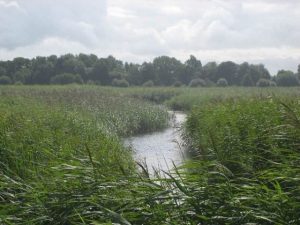
Reed warblers nest in reedbeds. As reeds grow and spread in the marshes, shallow waters, and damp soil they colonize, the reedbed will form. This image was taken by Sussex Wildlife Trust for their page on reedbeds: https://sussexwildlifetrust.org.uk/discover/around-sussex/wetland-habitats/reedbed
precision. Reed warblers – a small brown and white bird named for the wetland reedbeds nesting site in northern and western European countries, Britain, Germany, Scandinavia and more – will traverse across the Mediterranean Sea in southwestern Europe during migration to their winter homes in northern Africa and India. But how does a tiny warbler tell one wonderful reedy wetland from another after flying so far? Apparently, by marking, sensing and making sense of sensory cues found in the magnetic field. The study, titled Magnetic stop signs signal a European songbird’s arrival at the breeding site after migration, sheds light on the warblers’ spectacular sensory ability.
The Earth’s magnetic field, caused by electric currents in the earth’s core combined with solar winds that flow together across the planet’s surface like a giant soft and continuous, slow motion ocean wave, is detectable by birds. Scientists think that a protein in the cells of their eyes – Cry4, reacting to subtle changes of magnetic field light and color – is responsible for this super sensing ability. For humans, we need technology to take advantage of magnetic field information – GPS, smartphones and compasses, for example. There are three ways we describe magnetic field parameters: “inclination” (the “dip” or slope angle between Earth’s magnetic field above and Earth’s surface below), “delineation” (the angle between magnetic and true north), and “intensity” (the overall strength of Earth’s magnetic field in various locations). In general, the field is dynamic, shifting over time unlike a gridded map, and you might think it would be that much harder for birds navigating the shifts to get back to those same reedbeds. How could they do it? How do they know where and when to stop flying?
METHODS
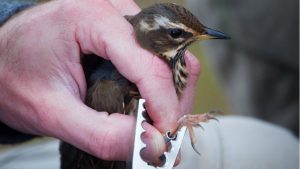
A researcher uses a banding pliers to secure the metal ring to the leg of a temporarily captured bird. This image was a resource used by BBC News: https://www.bbc.com/news/uk-50822772
Dr. Joe Wynn led a team at Oxford University who reviewed and analyzed 80 years of collected ‘ringing’ (or, bird band tracking) data in hopes of finding evidence that birds are actually using magnetic field cues to migrate. The ‘ringing’ data refers to the individually numbered metal or plastic rings that have been attached to bird wings or legs across Europe.
The recapturing of birds with rings assists in tracking movement, survival, and productivity. They analyzed 17,799 ringing recoveries from 1940 to 2018. And with knowledge from previous studies, the team understood that migratory birds inherit ‘clock and compass’ information from their parents, and that they may be using the Earth’s magnetic field as a navigation aid to orient themselves, but it was unclear just how.
They hypothesized that the warblers use cues for sensing some number or combination of the three magnetic field parameters – inclination, declination and/or intensity – in order to navigate. So the researchers began by looking at when and where the birds were re-captured. Then, they determined ways to compare actual and expected routes with the sites where birds had been recovered. To explore this, the researchers overlaid the inclination, declination and intensity parameter information separately and together in different combinations on top of documented “ringing” route maps.
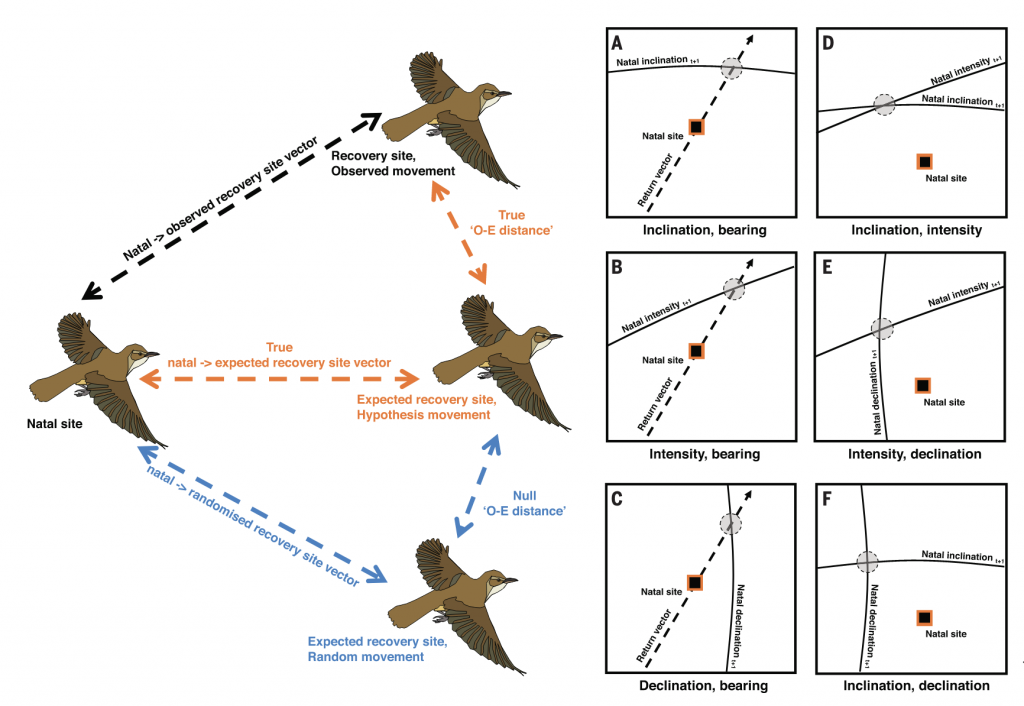
“Using the observed-versus-expected distance to test navigational hypotheses. (Left) The observed-versus-expected distance between the hypothesized and observed recovery sites (true O-E distance) can be calculated and compared with the distance between the hypothesized recovery site and the recovery site expected under equal but random movements (null O-E distance). Through this comparison, we can calculate the likelihood of a hypothesis outperforming chance. (A to F) Diagrams showing how expected recovery positions under each hypothesis are calculated.” Image and caption provided in the discussed study.
FINDINGS
The research team saw that as the Earth’s magnetic field moved, the nesting sites to which birds returned moved with it, suggesting that birds homed in on a moving magnetic target. And then with an even closer examination of the data, Wynn and his fellow researchers were surprised to see that only magnetic inclination affected the warblers’ return to their breeding grounds with significant accuracy.
“It’s this intersection of magnetic inclination with their inherited migratory route that tells birds when they’re home,” said Wynn.
The other parameter cues did not really influence where the birds were drawn to and eventually stopped to nest. Even accounting for other environmental factors like weather and temperature, inclination stood out as the main factor to signaling their own hatching grounds.
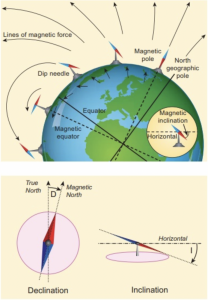
Magnetic Inclination https://www.brainkart.com/article/Earth—s-magnetic-field-and-magnetic-elements_38442/
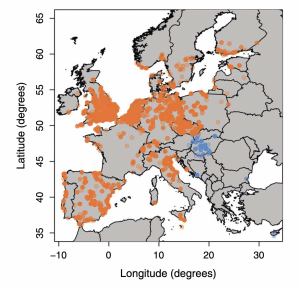
This map shows reed warbler ringings sites. The orange dots represent the birds migrating westward and the blue dots represent the birds migrating eastward. Image provided in the discussed study.
It’s logical that inclination angle sensory information is helpful to the warblers, which they most likely learn upon their own hatching and before setting out on their first migration south, because the inclination doesn’t change as much as the other cues, says Richard Holland, an animal behavior researcher at Bangor University. “Depending on the task they are doing, different cues might be important.” Other recent studies have previously indicated that birds orient themselves based on magnetic field information they detect.
CONCLUSION
This research is groundbreaking as there has been little evidence to show how birds are able to travel back to their natal or breeding sites. Dr. Wynn says this himself, stating that “whilst we know an increasing amount about how birds inherit migratory information from their parents, how they return to the same site year-on-year with pinpoint accuracy has remained elusive. It’s quite exciting, therefore, that we’ve been able to find evidence that magnetic cues could be used by songbirds trying to relocate their homes.” No longer such a profound mystery, it seems that animal magnetism is being re-defined.
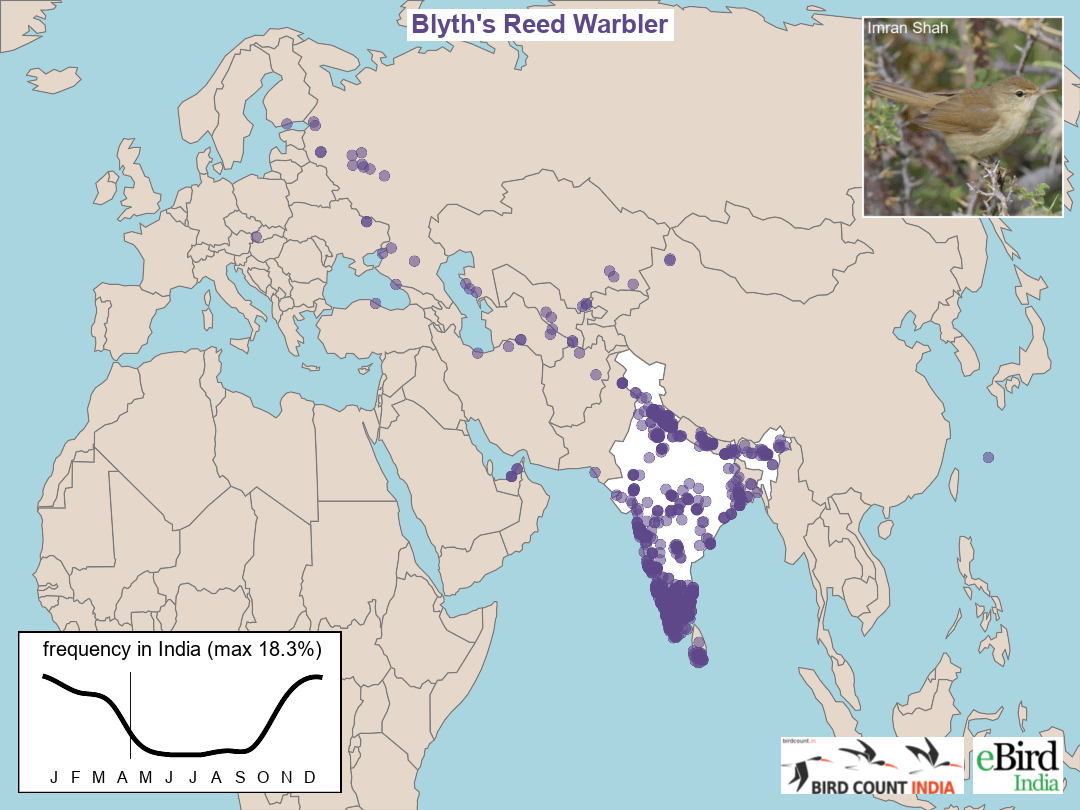
Reed warblers migration through northwestern India to the south. This graphic was constructed through the use of information gathered by bird watchers. This graphic was obtained from Bird Count India’s page of Blyth’s Reed Warblers: https://birdcount.in/migration-map/blrwar1/
